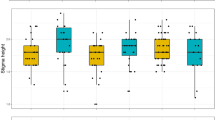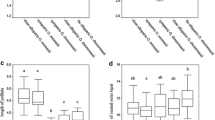Abstract
Reinforcement is the process by which selection favors traits that decrease mating between two incipient species in response to costly mating or the production of maladapted hybrids, causing the evolution of greater reproductive isolation between emerging species. I have studied a pair of orchids, Neotinea tridentata and N. ustulata, to examine the level of postmating pre- and post-zygotic isolating mechanisms that maintain these species, and the degree to which the boundary may still be permeable to gene flow. In this study, I performed pollen tube growth rate experiments and I investigated pre- and post-zygotic barriers by performing hand pollination experiments in order to evaluate fruit set, embryonate seed set and seed germination rates by intra- and interspecific crosses. Fruit set, the percentage of embryonate seeds and germinability of interspecific crosses were reduced compared to intraspecific pollinations, showing significant differences between sympatric and allopatric populations. While in allopatric populations the post-pollination isolation index ranged between 0.40 and 0.11, in sympatric populations orchid pairs showed total isolation due to post-pollination prezygotic barriers, guaranteed at the level of pollen–stigma interactions. Indeed, in sympatric populations, pollen tubes reached the ovary after 24 h in only 8 out of 45 plants; in the remaining cases, the pollen tubes did not enter the ovary, and thus no fruit set occurred. This pair of orchids is characterized by postmating pre-zygotic reproductive isolation in sympatric populations that prevents the formation of hybrids. This mechanism of speciation, starting in allopatry and triggering the reinforcement mechanisms of reproductive isolation in secondary sympatry, is the most likely explanation for the pattern of evolutionary transitions found in this pair of orchids.






Similar content being viewed by others
References
Abbott RJ, Rieseberg LH (2012) Hybrid speciation. Wiley, Chichester
Barton NH, Hewitt GM (1981) The genetic basis of hybrid inviability in the grasshopper Podisma pedestris. Heredity 47:367–383
Bateman RM, Hollingsworth PM, Preston J, Yi-Bo L, Pridgeon AM, Chase MW (2003) Molecular phylogenetics and evolution of Orchidinae and selected Habenariinae (Orchidaceae). Bot J Linn Soc 142:1–40
Bellusci F, Pellegrino G, Palermo AM, Musacchio A (2010) Crossing barriers between the unrewarding Mediterranean orchids Serapias vomeracea and S. cordigera. Plant Spe Biol 25:68–76
Bernardos S (2004) Cytotaxonomic study of some taxa of the subtribe Orchidinae (Orchidoideae, Orchidaceae) from the Iberian Peninsula. Isr J Plant Sci 52:161–170
Bogenhard C (1850) Taschenbuch der Flora von Jena. Wilhelm Engelmann, Leipzig
Coyne JA, Orr HA (2004) Speciation. Sinauer Associates, Sunderland
Cozzolino S, Aceto S, Caputo P, Menale B (1998) Characterization of Orchis × dietrichiana Bogenh., a natural orchid hybrid. Plant Biosyst 132:71–76
Delforge P (2005) Guide des Orchidées d’Europe, d’Afrique du Nord et du Proche- Orient. Delachaux et Niestlé, Neuchâtel-Paris
D’Emerico S, Cozzolino S, Pellegrino G, Pignone D, Scrugli A (2002) Heterochromatin distribution in selected taxa of the 42-chromosomes Orchis s.l. (Orchidaceae). Caryologia 55:55–62
Djordjević V, Tsiftsis S, Jakovljević K, Šinžar-Sekulić J, Vukojičić S (2012) First record of a natural hybrid Neotinea × dietrichiana (Orchidaceae) in Serbia. Phytol Balc 18:163–171
Dobzhansky T (1940) Speciation as a stage in evolutionary divergence. Am Nat 74:312–321
Fishman L, Wyatt R (1999) Pollinator-mediated competition, reproductive character displacement, and the evolution of selfing in Arenaria uniflora (Caryophyllaceae). Evolution 53:1723–1733
Gölz P, Reinhard HR (1986) Orchideen in Jugoslawien. Mitt Bl Arbeitskr Heim Orch Baden-Württemberg 18:689–827
Grant V (1966) The selective origin of incompatibility barriers in the plant genus Gilia. Am Nat 100:99–118
Higashiyama T, Kuroiwa H, Kuroiwa T (2003) Pollen-tube guidance: beacons from the female gametophyte. Curr Opin Plant Biol 6:36–41
Hopkins R (2013) Reinforcement in plants. New Phytol 197:1095–1103
Hopkins R, Rausher MD (2012) Pollinator-mediated selection on flower color allele drives reinforcement. Science 335:1090–1092
Kay KM, Schemske DW (2008) Natural selection reinforces speciation in a radiation of neotropical rainforest plants. Evolution 62:2628–2642
Kretzschmar H, Eccarius W, Dietrich H (2007) The Orchid Genera Anacamptis Orchis and Neotinea. Phylogeny, taxonomy, morphology, biology, distribution, ecology and hybridization. EchinoMedia Verlag, Bürgel
Lemmon AR, Kirkpatrick M (2006) Reinforcement and the genetics of hybrid incompatibilities. Genetics 173:1145–1155
Luca A, Palermo AM, Bellusci F, Pellegrino G (2015) Pollen competition between two sympatric Orchis species (Orchidaceae): the overtaking of conspecific on heterospecific pollen as a reproductive barrier. Plant Biol 17:219–225
McNeilly T, Antonovics J (1968) Evolution in closely adjacent plant populations. Barriers to gene flow. Heredity 23:205–218
Pellegrino G, Musacchio A, Noce ME, Palermo AM, Widmer A (2005) Reproductive versus floral isolation among morphologically similar Serapias L. species (Orchidaceae). J Hered 96:15–23
Pellegrino G, Bellusci F, Musacchio A (2009) Genetic integrity of sympatric hybridising plant species: the case of Orchis italica and O. anthropophora. Plant Biol 11:434–441
Pellegrino G, Bellusci F, Musacchio A (2010) Strong post-pollination pre-zygotic isolation between sympatric, food-deceptive Mediterranean orchids. Sex Plant Reprod 23:281–289
Pfennig KS, Pfennig DW (2009) Character displacement: ecological and reproductive responses to a common evolutionary problem. Quart Rev Biol 84:253–276
Ramsey J, Bradshaw HD, Schemske DW (2003) Components of reproductive isolation between the monkeyflowers Mimulus lewisii and M. cardinalis (Phrymaceae). Evolution 57:1520–1534
Reinhard H, Gölz P, Peter R, Wildermurth H (1991) Die Orchideen der Schweiz und angrenzender Gebiete. Fotorotar, Egg
Rieseberg LH, Willis JH (2007) Plant speciation. Science 317:910–914
Robertson C (1928) Flowers and insects. Lists of visitors of four hundred and fifty-three flowers. Science Press Printing Co, Lancaster
Schiestl FP, Dötterl S (2012) The evolution of floral scent and olfactory preferences in pollinators: coevolution or pre-existing bias? Evolution 66:2042–2055
Scopece G, Musacchio A, Widmer A, Cozzolino S (2007) Patterns of reproductive isolation in Mediterranean orchids. Evolution 61:2623–2642
Scopece G, Widmer A, Cozzolino S (2008) Evolution of postzygotic reproductive isolation in a guild of deceptive orchids. Am Nat 171:315–326
Servedio MR, Noor MAF (2003) The role of reinforcement in speciation: theory and data. Annu Rev Ecol Evol S 34:339–364
Silvertown J, Servaes C, Biss P, Macleod D (2005) Reinforcement of reproductive isolation between adjacent populations in the Park Grass Experiment. Heredity 95:198–205
Sobel JM, Chen GF (2014) Unification of methods for estimating the strength of reproductive isolation. Evolution 68:1511–1522
Soó R (1980) Orchis L. In: Tutin TG et al (eds) Flora Europaea. Cambridge University Press, Cambridge, pp 337–342
Tsiftsis S, Karagiannakidou V, Tsiripidis I (2007) The orchid flora of East Macedonia (NE Greece). J Eur Orch 39:489–526
van der Cingel NA (1995) An Atlas of Orchids Pollination–European Orchids. Balkema, Rotterdam
Van der Niet T, Johnson SD, Linder HP (2006) Macroevolutionary data suggest a role for reinforcement in pollination system shifts. Evolution 60:1596–1601
Van Waes JM, Derbergh PC (1986) In vitro germination of some Western European orchids. Physiol Plant 67:253–261
Vöth W (1984) Echinomyia magnicornis ZETT. Bestäuber von Orchis ustulata L. Die Orchidee 35:189–192
Whalen MD (1978) Reproductive character displacement and floral diversity in Solanum section Androceras. Syst Bot 3:77–86
Wheeler MJ, Franklin-Tong VE, Franklin FCH (2001) The molecular and genetic basis of pollen–pistil interactions. New Phytol 151:565–584
Zitari A, Scopece G, Helal AN, Widmer A, Cozzolino S (2012) Is floral divergence sufficient to maintain species boundaries upon secondary contact in Mediterranean food-deceptive orchids? Heredity 108:219–228
Author information
Authors and Affiliations
Corresponding author
Rights and permissions
About this article
Cite this article
Pellegrino, G. Sympatric reinforcement of reproductive barriers between Neotinea tridentata and N. ustulata (Orchidaceae). J Plant Res 129, 1061–1068 (2016). https://doi.org/10.1007/s10265-016-0855-7
Received:
Accepted:
Published:
Issue Date:
DOI: https://doi.org/10.1007/s10265-016-0855-7




